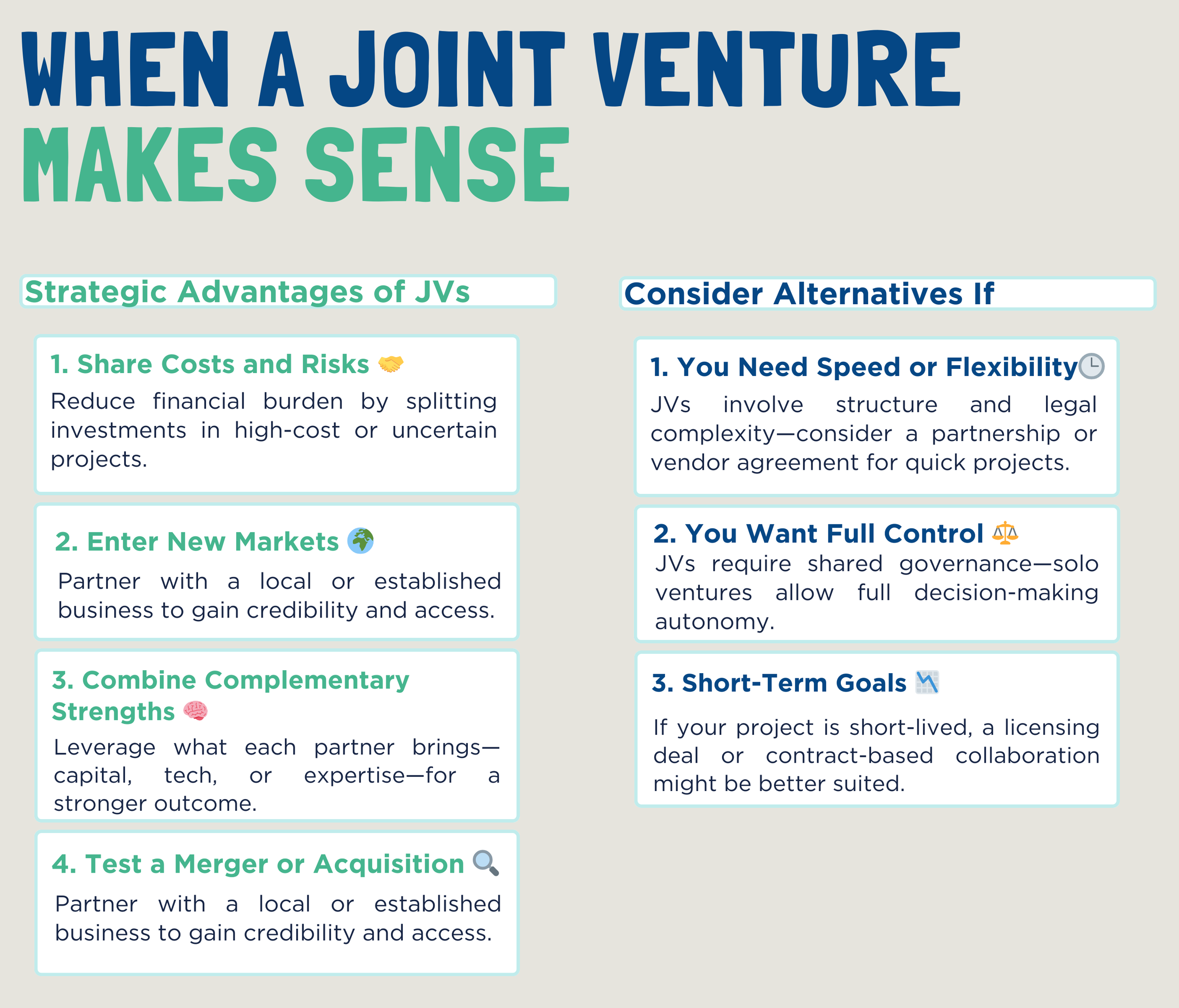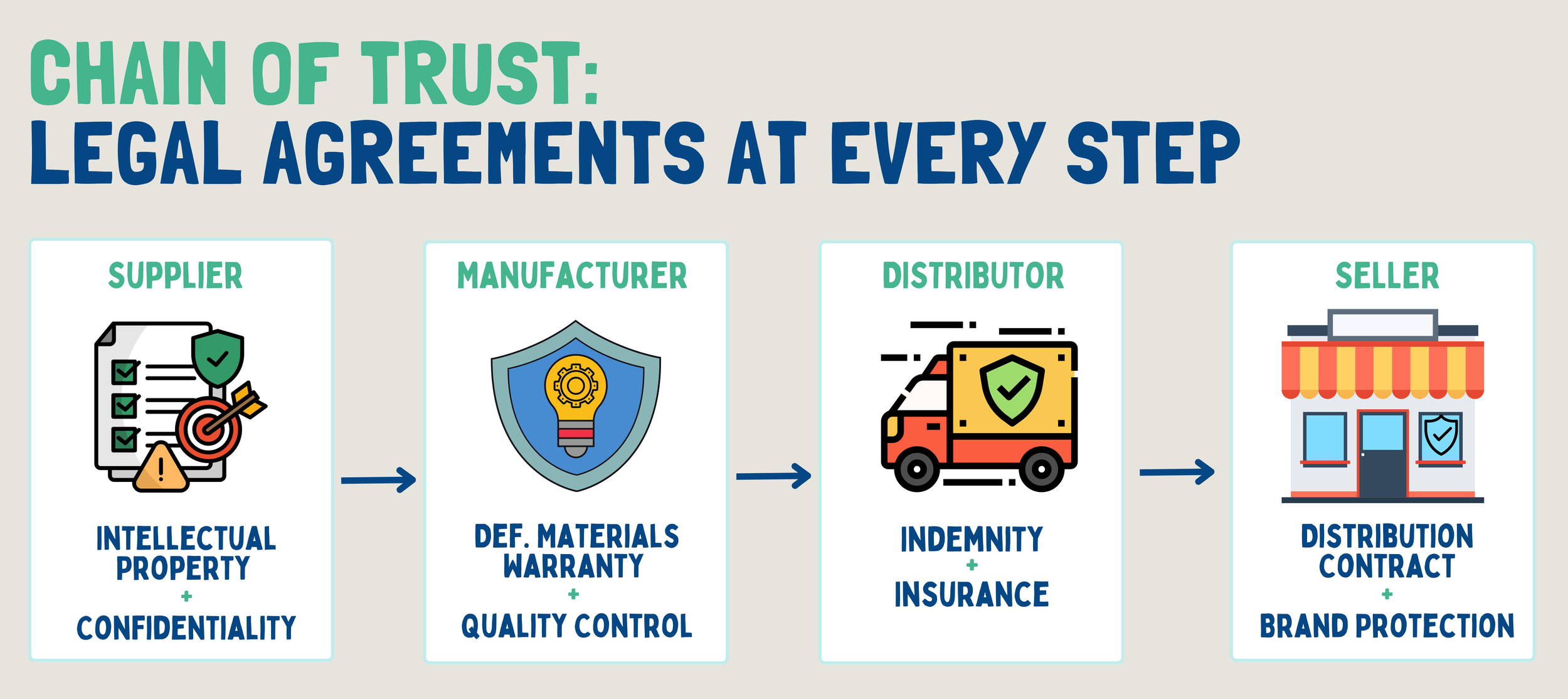Your Legal Guide to Joint Ventures
Joint ventures (JVs) can be a game-changer for startups and established businesses alike. Whether you’re pooling resources for a new technology, entering a competitive market, or splitting the risks of a large project, a JV allows you to partner strategically while staying independent. But joint ventures are complex. They’re long-term commitments, and getting the legal framework wrong can lead to costly disputes or even failure.
Here’s a practical guide to help you navigate the legal and strategic aspects of setting up a joint venture.
Why Start a Joint Venture?
Before diving into the legal mechanics, ask yourself: why a JV? Businesses pursue JVs for different reasons, including:
Sharing costs and risks: Large or speculative projects (like developing new technology) can be more feasible when risks and expenses are shared.
Accessing new markets or customers: A JV with an established player can provide instant credibility and market access.
Leveraging complementary assets: You may have cash, and your partner may have IP or technical expertise. Together, you can create something neither could build alone.
Exploring acquisition potential: JVs can act as a “trial run” for potential mergers or acquisitions without fully surrendering control.
A JV isn’t for every situation. If your goals are short-term or you want total control, consider a simpler collaboration like a licensing agreement or partnership.
When a Joint Venture Makes Sense
Step 1: Choose the Right Structure
One of the first decisions is whether to set up your JV as a separate entity (like an LLC or corporation) or handle it contractually without forming a new business.
Separate Entity: Ideal for complex, long-term ventures. This approach provides liability protection, governance flexibility, and a clear framework for ownership and profit sharing.
Contractual JV: Works well for narrow, short-term projects (e.g., developing specific technology). It avoids the costs and formalities of setting up a new entity but offers less structure and liability protection.
If you choose a separate entity, the type of business structure matters. LLCs offer flexibility in governance and taxation, while corporations may be better suited for ventures with future IPO potential. Always weigh liability, tax, and governance factors before deciding.
Step 2: Lock Down Contributions and Equity
Joint ventures rely on contributions—cash, assets, or services—from each party. Here’s how to approach this crucial step:
Define Contributions Clearly: Specify what each party is bringing to the table, whether it’s IP, equipment, or financial investment. Outline ownership and transfer terms to avoid disputes.
Value Non-Cash Assets: Intangible contributions like technology or customer lists can be tricky to value. Agree on valuations early to avoid disputes over equity shares.
Equity Distribution: Decide if contributions will result in equal ownership or if one party will hold a larger share. For example, if one partner contributes more cash, they might expect equity with liquidation preferences or other superior rights.
Step 3: Define Governance and Control
Governance can make or break a JV. Misaligned expectations about decision-making authority can lead to deadlocks or dysfunction. Address these key governance questions:
Who’s in Charge? Will the JV be board-managed, or will one party take the lead? Clearly outline roles and responsibilities in your agreements.
Minority Protections: If one partner holds a minority stake, ensure they have veto rights or approval power over major decisions to prevent being sidelined.
Deadlock Remedies: In 50/50 JVs or arrangements with veto rights, deadlocks are inevitable. Plan ahead with dispute resolution mechanisms like mediation, buy-sell provisions, or escalation to senior executives.
Step 4: Protect Intellectual Property (IP)
If your JV involves shared IP, make sure you have airtight agreements. Key considerations include:
Ownership: Determine whether the JV or an individual partner will own newly developed IP.
Licenses: If a partner contributes pre-existing IP, clarify usage rights and restrictions.
Enforcement: Specify how IP disputes will be resolved and who is responsible for policing infringement.
Step 5: Plan for an Exit
No one enters a JV thinking about its end, but exit strategies are critical. Whether the JV dissolves amicably or a partner wants to leave, having a plan prevents messy disputes. Common exit strategies include:
Buy-Sell Agreements: Allow one partner to buy out the other in case of default or disagreement.
Tag-Along/Drag-Along Rights: Protect minority partners during a sale (tag-along) or allow majority partners to force a sale of the entire JV (drag-along).
Winding Up the JV: Set triggers for dissolution, like achieving the venture’s goal or reaching a pre-agreed end date.
Step 6: Watch Out for Antitrust Issues
JVs, especially between competitors, can trigger antitrust scrutiny. Pay attention to:
Market Power: Avoid agreements that fix prices, limit output, or unfairly divide markets.
Information Sharing: Be cautious about sharing competitive information and set clear boundaries to avoid antitrust violations.
Chain of Trust: Legal Agreements at Every Step
Final Thoughts
A well-structured JV is a powerful tool for growth, innovation, and market expansion. But it’s not a handshake deal. It requires detailed planning and careful documentation. From governance to IP protection to exit strategies, every decision has long-term consequences.
Considering a joint venture? Work with experienced legal counsel to ensure your JV is built for success and designed to prevent disputes. Let’s talk.


